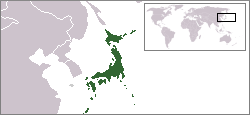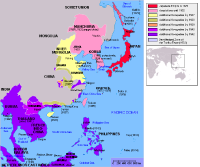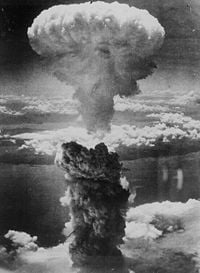Japan
Template:GAcc
- For other uses, see Japan (disambiguation).
| 日本国 Nihon-koku Nippon-koku |
||||||
|---|---|---|---|---|---|---|
|
||||||
| Motto: Peace and Progress (Emperor's motto) | ||||||
| Anthem: Kimigayo |
||||||
| Capital (and largest city) | Tokyo 35°41′N 139°46′E | |||||
| Official languages | Japanese | |||||
| Government | Constitutional monarchy | |||||
| Formation | ||||||
| Area | ||||||
| - | Total | 377,835 km² (63) 145,883 sq mi |
||||
| - | Water (%) | 0.8% | ||||
| Population | ||||||
| - | 2005 estimate | 127,417,244 (10th) | ||||
| GDP (PPP) | 2006 estimate | |||||
| - | Total | $4.167 trillion (3rd) | ||||
| - | Per capita | $32,640 (12th) | ||||
| GDP (nominal) | 2004 estimate | |||||
| - | Total | 4.8 trillion (2nd) | ||||
| Currency | Yen (¥) (JPY) |
|||||
| Time zone | JST (UTC+9) | |||||
| Internet TLD | .jp | |||||
| Calling code | +81 | |||||
| * Largest urban area. Yokohama is the largest incorporated city. | ||||||
Japan (Japanese: 日本国, Nihon; the older formal form is Nippon) is an island nation located on the Pacific Ocean, east of China and Korea, stretching from the Sea of Okhotsk in the north to the East China Sea in the south. It is composed of over 3,000 islands, the largest of which are Hokkaidō, Honshū, Shikoku, and Kyūshū. Most of Japan's islands are mountainous, and many are volcanic; the highest peak is Mount Fuji.
Japan is the world's second-largest economy after the U.S. and one of the world's leading industrialized countries. It is a unitary constitutional monarchy with an emperor and an elected parliament, one of the oldest legislatures in Asia. Despite its rugged terrain, it is one of the most populous—and one of the most densely populated—countries in the world. Its capital Tokyo, with over 30 million residents, is the largest metropolitan area in the world.
Historically, Japan adopted many customs and institutions from China and Korea, beginning in the 5th and 6th centuries. From the 12th century to the mid-1800s, Japan was a feudal country led by clans of warriors. After the Meiji Restoration of 1868, Japan adopted many European and American customs and institutions. Its culture today is a mixture of these influences along with traditional Japanese culture.
Japan's name in the kanji writing system is often translated as "Land of the Rising Sun", and comes from the country's location on the east coast of Asia.
Etymology
The English name "Japan" is believed to have been acquired by the Portuguese from southern Chinese languages via Malaya in the 16th century. In southern China, the country is referred to as "Yih-pun" or "Yat-bun", which literally means Sun Origin, referring to the country's location on the east coast of Asia. The name was exported to Southeast Asia through Chinese merchants. The earliest European form was Marco Polo's "Chipangu" which later became Japan.
The official Japanese name "Nippon" (in modern times, more commonly "Nihon") appeared in history only after 670. Old Book of Tang (舊唐書), one of the Twenty-Four Histories, stated that the Japanese envoy disliked his country's name "Woguo" (倭國), meaning "dwarf state", and changed it to "Nippon" (日本), or "Origin of the Sun". Another 8th-century chronicle, True Meaning of Shiji (史記正義), stated that the Chinese Empress Wu Zetian ordered a Japanese envoy to change the country's name to Nippon.
History
Pre-history
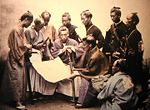 History of Japan |
|---|
|
|
|
Glossary |
Archaeological research indicates that the earliest inhabitants of the Japanese archipelago migrated over land bridges from Northeast Asia about 30,000 years ago. Other evidence also suggests that some may have later come by sea from Southeast Asia during a period of migration toward the Pacific Ocean.
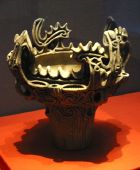
The first signs of civilization appeared around 10,000 B.C.E. with the Jomon culture, characterized by a Mesolithic to Neolithic semi-sedentary hunter-gatherer lifestyle of pit dwelling and a rudimentary form of agriculture. Weaving was still unknown and clothes were often made of bark. Around that time, however, the Jomon people started to make clay vessels, decorated with patterns made by impressing the wet clay with braided or unbraided cord and sticks (Jomon means "patterns of plaited cord"). This led to the introduction of the earliest known type of pottery in the world.
The start of the Yayoi period around 300 B.C.E. marked the influx of new practices such as rice farming, shamanism, and iron and bronze-making brought by migrants from Korea. These formed the basic elements of traditional Japanese culture, still seen today. As the population increased and society became more complex, they wove cloth, lived in permanent farming villages, constructed buildings of wood and stone, accumulated wealth through landownership and the storage of grain, and developed distinct social classes.
The ensuing Kofun era, beginning around AD 250, saw the establishment of strong military states centered around powerful clans. The Yamato court, concentrated in the Asuka region, suppressed the clans and acquired agricultural lands, increasing their power. Based upon the Chinese model, they developed a central administration and an imperial court system (the Ritsuryo state) and society was organized into occupation groups: farmers, fishermen, weavers, potters, artisans, armorers, and ritual specialists.
Classical era
The Japanese did not start writing their own histories until the 5th and 6th centuries, The beginning of Japanese historical writing culminated in the early 8th century with the massive chronicles, Kojiki (The Record of Ancient Matters, 712) and Nihonshoki (Chronicles of Japan, 720). Though Japan did not appear in written history until 57, when it is first mentioned in Chinese records as the nation of "Wa" (in Chinese, "Wo"), or "dwarf state", these chronicles tell a much different and much more legendary history of Japan, deriving the people of Japan from the gods themselves.
According to traditional Japanese mythology, Japan was founded in the 7th century B.C.E. by the ancestral Emperor Jimmu, a direct descendant of the Shinto deity Amaterasu. It is claimed that he started a line of emperors that remains unbroken, to this day. However, historians believe the first emperor who actually existed was Emperor Ojin, though the date of his reign is uncertain. Nonetheless, for most of Japan's history, real power has been in the hands of the court nobility, the shoguns, the military, or, more recently, prime ministers.
Through the Taika Reform Edicts of 645, Japanese intensified the adoption of Chinese cultural practices and reorganized the government in accordance with the Chinese administrative structure. This paved the way for the dominance of Confucian philosophy in Japan until the 19th century.
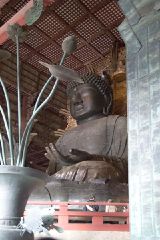
The Nara period of the 8th century marked the first strong Japanese state, centered around an imperial court, in the city of Heijo-kyo (now Nara). The imperial court later moved briefly to Nagaoka, and later Heian-kyo (now Kyoto), starting a "golden age" of classical Japanese culture called the Heian period which lasted for nearly four centuries and was characterized by the regency regime of the Fujiwara clan.
Medieval era
Japan's medieval era was characterized by the emergence of a ruling class of warriors, the Bushi or commonly known in the West as samurai. In the year 1185, following the defeat of the rival Taira clan, general Minamoto no Yoritomo was declared Sei-tai Shogun and established a base of power in Kamakura. After Yoritomo's death, another warrior clan, the Hojo, came to rule as regents for the shoguns. The shogunate managed to repel Mongol invasions from Mongol-occupied Korea in 1274 and 1281, with assistance from a storm that the Japanese interpreted as divine intervention, and named kamikaze (Divine Wind). The Kamakura shogunate lasted another fifty years. Its successor, the Ashikaga shogunate, was much weaker, and Japan soon fell into warring factions. Vassals rebelled against their liege lords and peasants rebelled against their superiors. The "Warring States" or Sengoku period ensued.
During the 16th century, traders and missionaries from Portugal reached Japan for the first time, initiating the Nanban ("southern barbarian") period of active commercial and cultural exchange between Japan and the West (and even China). During the last quarter of this century, Oda Nobunaga, Toyotomi Hideyoshi, and Tokugawa Ieyasu established increasingly strong control over the warring states of Japan. Nobunaga died in a treacherous attack by one of his generals whom he had humiliated earlier. Hideyoshi, one of Nobunaga's other general, avenged his master's death, defeated other rivals and completed the reunification of the country. Hideyoshi launched two ill-fated invasions against Korea together called the Seven-Year War, but Ming China came to Korea's aid and following Hideyoshi's death, Japanese troops were quickly withdrawn.
Ieyasu then dominated the political scene and defeated a coalition of rival clans. He was eventually declared Shogun and worked to consolidate the hold of his clan on Japan, setting up the bakuhan taisei system and implementing sankin-kotai to ensure the loyalty of the feudal lords. After Ieyasu, the Tokugawa shogunate began to pursue a policy of isolation. This period of isolation lasted for two and a half centuries, a time of tenuous political unity known as the Edo period, considered to be the height of Japan's medieval culture.
Modern era
Meiji Restoration
On March 31, 1854, Commodore Matthew Perry of the United States Navy forced the opening of Japan to the West with the Convention of Kanagawa. The Boshin War of 1867 to 1868 led to the resignation of the shogunate, and the Meiji Restoration established a government centered around the emperor. One of the main figures that helped bring change was Fukuzawa Yukichi, for example.
Imperial Japan
Japan adopted numerous Western institutions during the Meiji period, including a modern government, legal system, and military. These reforms helped transform the Empire of Japan into a world power, defeating China in the First Sino-Japanese War (1894-1895) and Russia in the Russo-Japanese War (1904-1905). The Russo-Japanese war is important because it was the first time that an Asian country defeated an imperialistic power. By 1910, Japan controlled Korea, Taiwan, and the southern half of Sakhalin.
The early 20th century saw a brief period of "Taisho democracy" overshadowed by the rise of Japanese expansionism. World War I enabled Japan, which fought on the side of the victorious Allies, to expand its influence in Asia, and its territorial holdings in the Pacific. In 1936, however, Japan signed the Anti-Comintern Pact, joining with Germany and Italy to form the Axis alliance. During this period, Japan invaded China, occupying Manchuria in 1931, and continued its expansion into China in 1937, starting the Second Sino-Japanese War, which lasted until the end of World War II. In 1941 Japan attacked the United States naval base in Pearl Harbor as well as British and Dutch colonies in Southeast Asia, bringing the United States into the war.
After a long campaign in the Pacific Ocean, Japan lost its initial territorial gains, and American forces moved close enough to begin strategic bombing of Tokyo, Osaka, and other major cities, as well as the atomic bombings of Hiroshima and Nagasaki. The Japanese eventually agreed to an unconditional surrender to the Allies on August 15, 1945 (V-J Day). The Tokyo War Crimes Tribunal was convened on May 31946 to prosecute Japanese war crimes, including atrocities like the Nanking Massacre. Emperor Hirohito, however, was given immunity and retained his title.
Modern Japan
The war cost millions of lives in Japan and other countries, especially in East Asia, and left much of the country's industries and infrastructure destroyed. Official American occupation lasted until 1952, although U.S. forces still retain important bases in Japan, especially in Okinawa. In 1947, Japan adopted a new pacifist constitution, seeking international cooperation and emphasizing human rights and democratic practices.
After the occupation, under a program of aggressive industrial development and U.S. assistance, Japan achieved spectacular growth to become one of the largest economies in the world. Despite a major stock market crash in 1990, from which the country is recovering gradually, Japan remains a global economic power today and is now bidding for a permanent seat on the United Nations Security Council.
Government and politics
In academic studies, Japan is generally considered a constitutional monarchy, based largely upon the British system with strong influences from European continental civil law countries such as Germany and France. For example, in 1896 the Japanese government established Minpo, the Civil Code, on the French model. With post-World War II modifications, the code remains in effect in present-day Japan. [1]
The parliament
The Constitution of Japan states that the nation's "highest organ of state power" is its bicameral parliament, the National Diet (Kokkai). The Diet consists of a House of Representatives (Lower House or Shūgi-in) containing 480 seats, elected by popular vote every 4 years or when dissolved, and a House of Councillors (Upper House or Sangi-in) of 242 seats, whose popularly-elected members serve six-year terms. There is universal adult (over 20 years old) suffrage, with a secret ballot for all elective offices.
The Cabinet is composed of a Prime Minister and ministers of state, and is responsible to the Diet. The Prime Minister must be a member of the Diet, and is designated by his colleagues. The Prime Minister has the power to appoint and remove ministers, a majority of whom must be Diet members. The liberal conservative Liberal Democratic Party (LDP) has been in power since 1955, except for a short-lived coalition government formed from its opposition parties in 1993; the largest opposition party is the liberal-socialist Democratic Party of Japan.
The Imperial household
The Imperial Household of Japan is headed by the Emperor of Japan. The Constitution of Japan defines the emperor to be "the symbol of the state and of the unity of the people". He performs ceremonial duties and holds no real power; not even emergency reserve powers. Power is mainly held by the Prime Minister, and other elected members of the Diet. Sovereignty is vested in the Japanese people by the constitution. Though his official status is disputed, on diplomatic occasions the emperor tends to behave (with widespread public support, it should be noted) as though he were a head of state. As of 2006 Japan is the only country in the world which is headed by an emperor.
Foreign relations
Japan is a member state of the United Nations and a non-permanent member of the Security Council; it is currently one of the "G4 nations" seeking permanent membership.
Japan's current constitution prohibits the use of military forces to wage war against other countries. However, the government maintains "Self-Defense Forces" which include air, land and sea components. Japan's deployment of non-combat troops to Iraq marked the first overseas use of its military since World War II.
As an economic power, Japan is a member of the G8 and APEC, and has developed relations with ASEAN as a member of "ASEAN plus three" and the East Asia Summit. It is a major donor in international aid and development efforts, donating 0.19% of its Gross National Income in 2004. [2]
Japan currently has territorial disputes with Russia over the Kuril Islands, with South Korea over the Liancourt Rocks, with China and Taiwan over the Senkaku Islands and with China over the status of Okinotori. These disputes are in part about the control of marine and natural resources, such as possible reserves of crude oil and natural gas.
In recent years, Japan has an ongoing dispute with North Korea over its abduction of Japanese citizens and nuclear weapons program.
Physical geography
Japan, a country of islands, extends along the eastern or Pacific coast of Asia. The main islands, running from north to south, are Hokkaido, Honshu (or the mainland), Shikoku, and Kyushu. Naha in the Ryukyu archipelago is over 600 kilometres (375 mi) to the southwest of Kyushu. In addition, about 3,000 smaller islands may be counted in the full extent of the archipelago.
Japan is the 18th most densely populated country in the world. About 73% of the country is mountainous [citation needed], and unsuitable for agricultural, industrial, or residential use, due to the generally steep elevations, climate, and risk of landslides caused by earthquakes, soft ground, and heavy rain. This has resulted in an extremely high population density in the habitable zones that are mainly located in coastal areas.
Its location on the Pacific Ring of Fire, at the juncture of three tectonic plates, gives Japan frequent low-intensity earth tremors and occasional volcanic activity. Destructive earthquakes, often resulting in tsunamis, occur several times each century. The most recent major quakes include the 2004 Chuetsu Earthquake and the Great Hanshin Earthquake of 1995. Hot springs are numerous, and have been developed as resorts.
The climate of Japan is predominantly temperate but varies greatly from north to south. Japan's geographical features divide it into six principal climatic zones:
- Hokkaido: The northernmost zone has a temperate climate with long, cold winters and cool summers. Precipitation is not heavy, but the islands usually develop deep snow banks in the winter.
- Sea of Japan: On Honshu's west coast, the northwest wind in the wintertime brings heavy snowfall. In the summer, the region is cooler than the Pacific area, though it sometimes experiences extremely hot temperatures, due to the Föhn wind phenomenon.
- Central Highlands: A typical inland climate, with large temperature differences between summer and winter, and between day and night. Precipitation is light.
- Seto Inland Sea: The mountains of the Chugoku and Shikoku regions shelter the region from the seasonal winds, bringing mild weather throughout the year.
- Pacific Ocean: The east coast experiences cold winters with little snowfall and hot, humid summers due to the southeast seasonal wind.
- Southwest Islands: The Ryukyu Islands have a subtropical climate, with warm winters and hot summers. Precipitation is very heavy, especially during the rainy season. Typhoons are common.
The main rainy season begins in early May in Okinawa, and the stationary rain front responsible for this gradually works its way north until it dissipates in northern Japan before reaching Hokkaido in late July. In most of Honshu, the rainy season begins before the middle of June and lasts about six weeks. In late summer and early autumn, typhoons often bring heavy rain.
Japan is home to nine forest ecoregions which reflect the climate and geography of the islands. They range from subtropical moist broadleaf forests in the Ryukyu and Bonin islands, to temperate broadleaf and mixed forests in the mild climate regions of the main islands, to temperate coniferous forests in the cold, winter portions of the northern islands.
Administrative subdivisions
Japan is divided into 47 prefectures, which are commonly grouped into regions. Honshu, by far the largest and most populated island, is typically divided into five (or more) regions. The other major islands constitute one region each. From north to south, the regions are:
| Region | Prefectures |
|---|---|
| Hokkaidō | Hokkaidō |
| Tōhoku | Akita, Aomori, Fukushima, Iwate, Miyagi, Yamagata |
| Kantō | Chiba, Gunma, Ibaraki, Kanagawa, Saitama, Tochigi, Tokyo |
| Chubu | Aichi, Fukui, Gifu, Ishikawa, Nagano, Niigata, Shizuoka, Toyama, Yamanashi |
| Kansai | Hyōgo, Kyoto, Mie, Nara, Osaka, Shiga, Wakayama |
| Chūgoku | Hiroshima, Okayama, Shimane, Tottori, Yamaguchi |
| Shikoku | Ehime, Kagawa, Kōchi, Tokushima |
| Kyūshū | Fukuoka, Kagoshima, Kumamoto, Miyazaki, Nagasaki, Oita, Saga |
| Okinawa | Okinawa |
The prefectures are further subdivided into cities, towns and villages. Major cities are divided into wards, and the central portion of Tokyo is divided into 23 special wards.
Economy
Japan is a major economic global power. Government-industry cooperation, a strong work ethic [citation needed], mastery of high technology [citation needed], emphasis on education [citation needed], and a comparatively small defense allocation[citation needed] have helped Japan advance with extraordinary speed to become one of the largest economies in the world. For three decades, overall real economic growth had been spectacular: a 10% average in the 1960s, a 5% average in the 1970s, and a 4% average in the 1980s [citation needed]. Growth slowed markedly in the 1990s largely due to the after-effects of over-investment during the late 1980s and domestic policies intended to wring speculative excesses from the stock and real estate markets. Government efforts to revive economic growth have met with little success and were further hampered in 2000 to 2001 by the slowing of the global economy.
However, the economy saw signs of strong recovery in 2005. GDP growth for the year was 2.8%, with a fourth quarter expansion of 5.5% [citation needed], surpassing the growth rate of the US and European Union during the same period. Unlike previous recovery trends, domestic consumption has been the dominant factor in leading the growth. Hence, the Japanese government predicts that recovery will continue in 2006. In March 2006 the core Consumer Price Index (CPI) showed a positive growth for the first time in 8 years [citation needed].
Distinguishing characteristics of the Japanese economy include the cooperation of manufacturers, suppliers, distributors, and banks in closely-knit groups called keiretsu; the powerful enterprise unions and shuntō; cozy relations with government bureaucrats, and the guarantee of lifetime employment (shushin koyo) in big corporations and highly unionized blue-collar factories. Recently, Japanese companies have begun to abandon some of these norms in an attempt to increase profitability.
The current government of Junichiro Koizumi has enacted or attempted to pass (sometimes with failure) major privatization and foreign-investment laws intended to help stimulate Japan's dormant economy. Although the effectiveness of these laws is still ambiguous, the economy has begun to respond, but Japan's aging population is expected to place further strain on growth in the near future. [3]
Agricultural sector
Japan uses a system of terrace farming to build in a small area due to lack of available land. Japanese agriculture has one of the world's highest levels of productivity per unit area. Japan's small agricultural sector, however, is also highly subsidized and protected, with government regulations that favor small-scale cultivation instead of large-scale agriculture as practiced in North America. Imported rice, the most protected crop, is subject to tariffs of 490% [citation needed] and restricted to a quota of only 3% [citation needed] of the total rice market. Although Japan is usually self-sufficient in rice (except for its use in making rice crackers and processed foods), the country must import about 50% [citation needed] of its requirements of other grain and fodder crops, and relies on imports for most of its supply of meat. Japan maintains one of the world's largest fishing fleets and accounts for nearly 15% of the global catch [citation needed], prompting some claims that Japan's fishing is leading to depletion in fish stocks [citation needed] such as tuna. Japan has also sparked controversy [citation needed] by supporting quasi-commercial whaling.
Industrial sector
Industry, one-fourth of Japan's GDP, depends heavily on imported raw materials and fuels. Internationally, Japan is best known for its automotive, optics, chemical and electronics industries, as the home of big manufacturers such as Toyota, Sharp, Yamaha, Honda, Nissan, Mitsubishi, Mazda, Sony, Matsushita, Toshiba, Suzuki, and Hitachi, as well as household names like Nikon Corporation. Japan also holds a large market share in high-technology industries such as semiconductors, industrial chemicals, machine tools, and (in recent years) aerospace. Construction has long been one of Japan's largest industries, with the help of multi-billion-dollar government contracts in the civil sector. Robotics constitutes a key long-term economic strength.
Service sector
Japan's service sector accounts for about three-fourths of its total economic output. Banking, insurance, real estate, retailing, transportation, and telecommunications are all major industries. The Koizumi government is attempting to privatize Japan Post, one of the country's largest providers of savings and insurance services, by 2007.
Society
Demographics
Japanese society is linguistically, though not ethnically, homogeneous with small populations of primarily Ryukyuans (1.5 million), North and South Koreans (0.6 million), Chinese and Taiwanese (0.5 million), Filipinos (0.5 million) and Brazilians (250,000) [citation needed]. Japan also has indigenous minority groups such as the Ainu, Ryukyuans and burakumin. Japanese citizenship is conferred jus sanguinis, and monolingual Japanese-speaking minorities often reside in Japan for generations under permanent residency status without acquiring citizenship in their country of birth. About 99% of the population speaks Japanese as their first language.
Japan has the highest life expectancy in the world: 85.2 years for women and 78.3 years for men in 2002. [4] However, the Japanese population is rapidly aging, the effect of a postwar baby boom followed by a decrease in births in the latter part of the 20th century. By 2007, over 20% of the population will be over the age of 65 [citation needed]. The changes in the demographic structure have created a number of social issues, particularly a potential decline in the workforce population and increases in the cost of social securities like the public pension plan.
The population started declining in 2005, as the 1.067 million births were exceeded by the 1.077 million deaths [citation needed]. At current birth and death rates, the 2005 population of 128 million is expected to decline to 100 million in 2050, and to 64 million in 2100. Demographers and government planners are currently in a heated debate over how to cope with this problem. [5] Immigration and birth incentives are sometimes suggested as a possible solution to provide younger workers to support the nation's aging population. Immigration, however, is not publicly popular as recent increased crime rates are often attributed to foreigners living in Japan. [citation needed]
Religion
- Main articles: Religion in Japan and Japanese mythology
The Japanese people's concern towards religion is mostly related to mythology, traditions, and neighborhood activities rather than the source of morality or the guideline for one's life, for which sometimes Confucianism, or even Taoism, tends to serve as the basis for the moral code. When asked to identify their religion, most would profess to believe in either Shintoism (54%) or Buddhism (40%) [citation needed], for simple reasons like their family has belonged to some sect of Buddhism or to avoid contention with religious foreigners. Nonetheless, most of the people are not atheists, and the tendency is often identified with syncretism, secularism, and even irreligion. This results in a variety of practices such as parents and children celebrating Shinto rituals, students praying before exams, couples holding a wedding at a Christian church and funerals being held at Buddhist temples. A minority profess to Christianity (0.7%) and other religions (4.7%) like shamanism, Islam, and Hinduism. Also, since the mid-19th century, many religious sects called shinkoshukyo, and later shinshukyo, emerged.
Education
Compulsory education was introduced into Japan in 1872 as one result of the Meiji Restoration. Since 1947, compulsory education consists of elementary school and middle school, which lasts for 9 years (from age 6 to age 15). Almost all children continue their education at a three-year senior high school, and 96% of high school graduates attend a university, junior college, trade school, or other post-secondary institution.
Language
The Japanese language is an agglutinative language distinguished by a system of honorifics reflecting the hierarchical nature of Japanese society, with verb forms and particular vocabulary which indicate the relative status of speaker and listener. There is no consensus on what, if any, relationship Japanese has with other languages, but scholars continue to research the issue.
Japanese incorporates many foreign elements. Much as English has borrowed learned vocabulary from Latin, Japanese has borrowed or derived significant amounts of vocabulary from Chinese. Japanese also has extensive borrowings from English. The writing system uses kanji (Chinese characters) and two sets of kana (syllabaries based on simplified forms of Chinese characters), as well as the Roman alphabet and Hindu-Arabic numerals.
Japan's official language is Japanese, and about 99% of the population speaks Japanese as their first language. The Ryukyuan languages, the other member of the Japonic language family, are spoken in Okinawa, but few children are learning these languages now. Ainu, the language of the indigenous minority, is moribund, with only a few elderly speakers remaining in Hokkaido. Most public and private schools require students to take courses in both Japanese and English.
Culture
Japanese culture has evolved greatly over the years, from the country's original Jomon culture to its contemporary hybrid culture, which combines influences from Asia, Europe, and North America.
Historically, China and Korea and have been the most influential starting with the development of the Yayoi culture from around 300 BC and culminating with the introduction of rice farming, ceremonial burial, pottery, painting, writing, poetry, etiquette, the Chinese writing system, and Mahayana Buddhism by the 7th century AD.
In the pre-modern era, Japan developed a distinct culture, in its arts: (ikebana, origami, ukiyo-e), crafts (dolls, lacquerware, pottery), performances (bunraku, dance, kabuki, noh, rakugo), traditions (games, onsen, sento, tea ceremony, budo, architecture, gardens, swords), and cuisine.
From the mid-19th century onward, Western influence prevailed, with American influence becoming especially predominant following the end of World War II. This influence is apparent in Japan's contemporary popular culture, which combines Asian, European, and, 1950-onward, American influences.
Today, Japan is a major exporter of its own popular culture, which has gained popularity around the world, particularly in other East Asian countries and some areas of the United States. Many Japanese have also achieved international acclaim in fashion, film, literature, television, and music. Emerging and growing trends in Japanese culture include some of the highest-quality video games and game consoles, as well as a wide variety of graphic novels (usually called manga) and animated films (usually called anime) with distinctive artistic styles imitated the world over. As a result, many aspects of Japanese popular culture have attracted many devotees in Europe and North America.
Notes
- ↑ "Japanese Civil Code", Encyclopædia Britannica. Retrieved 14 May 2006.
- ↑ Net Official Development Assistance In 2004, Organisation for Economic Co-operation and Development, 11 April 2005. Retrieved 14 May 2006.
 PDF
PDF
- ↑ "Japan, Refutation of Neoliberalism", Post-Autistic Economics Network, 5 January 2004. Retrieved 14 May 2006.
- ↑ Vital statistics summary and expectation of life at birth: 1999-2003, United Nations Statistics Division. Retrieved 14 May 2006.
 PDF
PDF
- ↑ "Demographic Trends and Their Implications for Japan's Future", The Ministry of Foreign Affairs of Japan, 7 March 1997. Retrieved 14 May 2006.
ReferencesISBN links support NWE through referral fees
- S. N. Eisenstadt, Japanese Civilization: A Comparative View, University of Chicago 1995. (ISBN 0226195589)
- Japan a Profile of Nation, Kodansha International, 1999. (ISBN 4770023847)
- The Cambridge Encyclopaedia of Japan, Cambridge Univ. Press, 1993 (ISBN 0521403529)
- De Mente, The Japanese Have a Word For It, McGraw-Hill, 1997 (ISBN 0844283169)
- Henshall, A History of Japan, Palgrave Macmillan, 2001 (ISBN 0312233701)
- Jansen, The Making of Modern Japan, Belknap, 2000 (ISBN 0674003349)
- Japan At A Glance, Kodansha, 1998 (ISBN 4770020805)
- Johnson, Japan: Who Governs?, W.W. Norton, 1996 (ISBN 0393314502)
- Lonely Planet Japan, Lonely Planet Publications, 2003 (ISBN 1740591623)
- Reischauer, Japan: The Story of a Nation, McGraw-Hill, 1989 (ISBN 0075570742)
- Sugimoto et al., An Introduction to Japanese Society, Cambridge Univ. Press, 2003 (ISBN 0521529255)
- Totman, A History of Modern Japan, 2d ed., Blackwell, 2005 (ISBN 1405123591)
- Van Wolferen, The Enigma of Japanese Power, Vintage, 1990 (ISBN 0679728023)
Miscellaneous topics
| Topic | Article |
|---|---|
| History | Paleolithic, Jomon, Yayoi, Yamato, Nara, Heian, Kamakura, Muromachi, Azuchi-Momoyama, Edo, Meiji, Taishō, Shōwa, Heisei |
| Government & Politics |
Emperor (list), Prime Minister (list), Cabinet, Ministries, National Diet, House of Councillors, House of Representatives, Judicial system, Elections, Political parties, Fiscal policy, Foreign policy, Foreign relations, Human rights, Military of Japan |
| Geography |
Environment, Regions, Prefectures, Cities, Districts, Towns, Villages, Addresses, Islands, Lakes, Rivers |
| Economy |
Agriculture, forestry, and fishing, Manufacturing, Labor, Communications, Transportation, Currency, Bank of Japan |
| Society |
Demographics, Religion, Mythology, Education, Language, Culture |
External links
Official
|
MediaOther |
| UN Security Council Members | |
|---|---|
| Permanent Members | |
| China - France - Russia - United Kingdom - United States | |
| Members 2021-2022 | |
| India - Ireland - Kenya - Mexico - Norway | |
| Members 2022-2023 | |
| Albania - Brazil - Gabon - Ghana - United Arab Emirates | |
| Group of Eight |
|---|
| Canada | France | Germany | Italy | Japan | Russia | United Kingdom | United States |
Template:East Asia
Credits
New World Encyclopedia writers and editors rewrote and completed the Wikipedia article in accordance with New World Encyclopedia standards. This article abides by terms of the Creative Commons CC-by-sa 3.0 License (CC-by-sa), which may be used and disseminated with proper attribution. Credit is due under the terms of this license that can reference both the New World Encyclopedia contributors and the selfless volunteer contributors of the Wikimedia Foundation. To cite this article click here for a list of acceptable citing formats.The history of earlier contributions by wikipedians is accessible to researchers here:
The history of this article since it was imported to New World Encyclopedia:
Note: Some restrictions may apply to use of individual images which are separately licensed.


